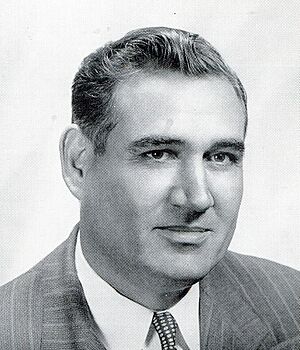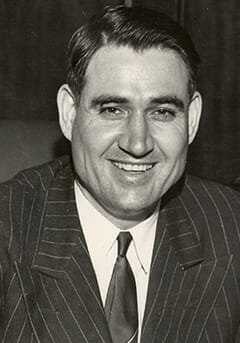Jim Folsom facts for kids
Quick facts for kids
Jim Folsom
|
|
|---|---|

Official portrait, 1955
|
|
| 42nd Governor of Alabama | |
| In office January 17, 1955 – January 19, 1959 |
|
| Lieutenant | William G. Hardwick |
| Preceded by | Gordon Persons |
| Succeeded by | John Malcolm Patterson |
| In office January 20, 1947 – January 15, 1951 |
|
| Lieutenant | James C. Inzer |
| Preceded by | Chauncey Sparks |
| Succeeded by | Gordon Persons |
| Personal details | |
| Born |
James Elisha Folsom
October 9, 1908 Coffee County, Alabama, U.S. |
| Died | November 21, 1987 (aged 79) Cullman, Alabama, U.S. |
| Political party | Democratic |
| Spouses |
Sarah Carnley
(m. 1936; died 1944)Jamelle Moore
(m. 1948) |
| Children | 10 (including Jim) |
| Alma mater | University of Alabama Samford University George Washington University |
| Military service | |
| Branch | United States Army United States Merchant Marine |
| Wars | World War II |
James Elisha Folsom Sr. (October 9, 1908 – November 21, 1987), known as Jim Folsom or Big Jim Folsom, was an American politician. He served as the 42nd governor of the U.S. state of Alabama. He held this office from 1947 to 1951, and again from 1955 to 1959. He was the first Governor of Alabama born in the 20th century.
Contents
Early Life and Education
Jim Folsom was born in Coffee County, Alabama, in 1908. His family had English roots.
Before serving in the United States Army and United States Merchant Marine during World War II, Folsom worked as an insurance salesman. He attended several universities, including the University of Alabama, Samford University in Birmingham, and George Washington University in Washington, D.C.. However, he did not complete a college degree.
Becoming Governor of Alabama
Folsom was first elected governor in 1946. He ran on a platform that supported ideas similar to the New Deal. He often spoke out against powerful companies and wealthy groups.
His campaigns were very lively. He would travel with a country music band and carry a mop and bucket. He said he would "clean out" the Capitol. His opponent, Handy Ellis, tried to scare voters by saying Folsom would harm segregation laws and support "communist-backed labor unions."
Folsom's Political Beliefs
Historian Dan T. Carter described Folsom's ideas about democracy. He believed that a democratic society needed three main things:
- The Bill of Rights (which protects people's freedoms).
- A government that actively helps its citizens.
- Complete and total democracy for everyone.
Folsom warned people that after World War II, which was fought "against hatred and violence," some people would try to divide others. He said they would use false ideas to create problems between different races, social classes, and religions.
Advocating for Civil Rights
Jim Folsom was one of the first governors in the Southern U.S. to take a moderate stance on racial integration. He also worked to improve civil rights for African Americans.
In his Christmas message on December 25, 1949, he shared an important message. He said, "As long as the Negroes are held down by deprivation and lack of opportunity, the other poor people will be held down alongside them." This showed his belief that everyone's well-being was connected.
Second Term and Key Reforms
Despite some challenges during his first term, Folsom was easily elected for a second term in 1954. The Alabama Constitution at that time did not allow a governor to serve two terms in a row.
During his campaign, Folsom spoke out against the Ku Klux Klan. He also promised to provide free textbooks for children. He was very tall, standing 6 feet 8 inches. His campaign slogan was "the little man's big friend," showing his support for everyday people.
In 1958, Folsom stopped the death sentence for James E. Wilson. Wilson was an African American man sentenced to death for robbery. This case caused protests around the world. Folsom opposed the death penalty. He often granted mercy in death penalty cases if he could find a reason. He also regularly released or pardoned Black prisoners. He believed they were often unfairly treated because of their race.
Important Changes During His Time in Office
Many important changes happened during Folsom's two terms as governor.
- Healthcare: A law was passed to help poor people pay for hospital care.
- Worker Rights: Unemployment benefits were increased.
- Child Labor: A law in September 1947 raised the minimum age for children to work during school hours from 14 to 16. This did not include farm work or domestic service. The law also reduced the maximum workweek for children from 48 to 40 hours.
- Worker Safety: In 1949, laws were passed to improve safety in coal mines.
- Worker's Compensation: Changes were made to worker's compensation laws in June 1949. This included full benefits for 550 weeks for permanent total disability.
- Wage Protection: In August 1957, a law increased the amount of a worker's wages that could not be taken for debt from 60% to 75%.
- Medical Benefits: Another law in August 1957 increased maximum medical benefits for workers from $1,000 to $1,200. It also extended the period for these benefits from 90 days to 6 months.
During his first term, Folsom also helped improve rural life. He secured a loan for an electric cooperative. He also started a program for "farm-to-market roads." These roads made it easier for farmers to get their goods to cities. He also increased salaries for schoolteachers. Funding for health, welfare, education, and old-age pensions also went up. For example, the budget for 1947-49 included a large amount for old-age pensions. This increased the average monthly check for pensioners and helped more people receive benefits. He also supported the largest amount of money ever for public education in Alabama at that time.
Later Political Campaigns
After his second term, Folsom ran for governor several more times.
- In 1962, he ran against George C. Wallace, who had once been his supporter, but Folsom lost.
- He ran again in 1966. The winner of that election was Lurleen Burns Wallace, the first wife of George Wallace.
- Folsom continued to run for governor in 1970, 1974, 1978, and 1982. However, he was not seen as a serious candidate by his opponents in these later races.
- In the 1970 race, Folsom spoke out against the Vietnam War, high taxes, and "race against race politics." He famously said, "I'm the first and the last Governor the little man, the young people and the blacks ever had in Alabama."
Later Life and Legacy
In his final years, Jim Folsom faced health problems. By 1976, he was legally blind and nearly deaf.
Folsom passed away in 1987 in Cullman.
In Pop Culture
Jim Folsom's life has been featured in films:
- A documentary film about him, Big Jim Folsom: The Two Faces of Populism, was made in 1996 by Alabama filmmaker Robert Clem. It won awards in 1997.
- In the 1997 TNT movie George Wallace, actor Joe Don Baker played Jim Folsom. Baker was nominated for an award for his performance.
Family Life
Folsom married Sarah Carnley, a teacher, in 1936. She passed away in 1944.
In 1948, Folsom married Jamelle Folsom, whose maiden name was Jamelle Moore. They had met during his 1946 campaign. They remained married until his death.
Jim Folsom had ten children in total.
His son, James E. Folsom Jr., also became a well-known politician in Alabama. He was known as "Little Jim" because of his father's nickname. He served as lieutenant governor of Alabama from 1987 to 1993. He became governor when the previous governor was removed from office. Jim Folsom Jr. later served as lieutenant governor again from 2007 to 2011.
Folsom's niece, Cornelia Wallace, was the second wife of his former political rival, George Wallace.
See also
- List of members of the American Legion


